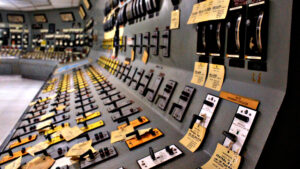By John Victor D. Ordoñez, Reporter
THE PHILIPPINE government should build state-of-the-art nuclear power plants instead of trying to revive the mothballed Bataan Nuclear Power Plant (BNPP), which may be too old to function, Philippine senators said at the weekend.
“The Bataan Nuclear Power Plant should be separated from the talks about the adoption of nuclear energy here in the Philippines,” Senate Minority Leader Aquilino “Koko” D. Pimentel III told BusinessWorld in a Viber message.
“That plant is beyond rehabilitation. That cannot be used anymore as an operating nuclear plant. It’s too dangerous.”
He said considering nuclear power is crucial since technology has improved over the years, but the government should also look at other sources of energy to address its power generation issues.
Last week, Philippine President Ferdinand R. Marcos, Jr. and South Korean President signed a deal to conduct a feasibility study on the rehabilitation of the BNPP. The Department of Energy and Korea Hydro & Nuclear Power Co., Ltd. agreed to hold a comprehensive technical and economic feasibly study on the plant.
Manila Electric Co. (Meralco) and South Korea’s Doosan Enerbility Co. Ltd. have also signed a deal to collaborate on low-carbon energy projects and the deployment of nuclear power facilities.
The 620-megawatt Bataan Nuclear Plant was built during the administration of the late dictator President Ferdinand E. Marcos, Sr. and was shut down in 1986 amid corruption allegations and safety concerns. Its construction was completed in the 1980s but it was never used.
Senator Sherwin T. Gatchalian, who heads the Senate ways and means committee, noted that while the Bataan plant might be the quickest route to harnessing nuclear energy, the government is better off exploring modern nuclear technology.
“It would be more prudent for the country to use the latest and safest nuclear technology in it first foray into nuclear power,” he said in a Viber message.
Mr. Gatchalian added that Manila could seek Seoul’s help through the Korea Electric Power Corp. (KEPCO) to determine if reviving the Bataan plant is “commercially feasible and safe.”
Meanwhile, Senate Deputy Majority Floor Leader Joseph Victor G. Ejercito said he is open to reopening the BNPP. “South Korea should have the expertise and experience to assist our nuclear program,” he said in a Viber message.
“The BNPP has been demonized, but it seems people now have realized the benefits of nuclear energy source as many countries like the US, France and other European countries have developed tremendously because of a successful energy mix that includes nuclear power.”
The Department of Energy expects nuclear power to start feeding into the country’s grids by 2032, Energy Director Michael O. Sinocruz earlier told congressmen.
Washington and Manila’s Agreement for Cooperation Concerning Peaceful Uses of Nuclear Energy, also known as the 123 Agreement, entered into force on July 2, the US State Department said in a statement on July 9. Both countries signed the deal in November.
The pact provides a legal framework for the export of nuclear materials, equipment and components from the US to the Philippines.
The House of Representatives last year passed on final reading a bill that seeks to establish a Philippine Atomic Regulatory Authority that will oversee the use of nuclear energy in the country.
“South Korea, like the US, is a major exporter of nuclear energy and so has a vested interest in promoting this so they can sell their technology and expertise abroad,” Ibon Foundation Executive Director Jose Enrique “Sonny” A. Africa said in a Viber message.
“The strategic direction of energy development in the Philippines should be towards an indigenously provided and run renewable energy as possible,” he added.
The Philippines is hard-pressed to find other sources of indigenous energy as the Malampaya gas field, which supplies a fifth of its power requirements, nears depletion.
The gas field is expected to run out of easily recoverable gas by 2027.
Manila plans to raise the share of renewable energy in the country’s energy mix to 35% by 2030 and to 50% by 2040 from 22% now.
Senators are set to continue deliberations on a bill that seeks to promote the production of indigenous natural gas and liquefied natural gas, which the government sees as a transition fuel toward adopting more renewable energy sources.
“While there are risks from nuclear plants, nuclear energy is a source of clean, stable energy that can offset the fluctuations from intermittent sources like water and wind,” Foundation for Economic Freedom President Calixto V. Chikiamco said in a Viber message.
